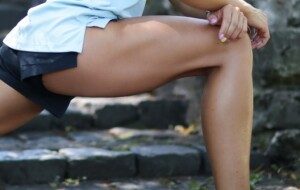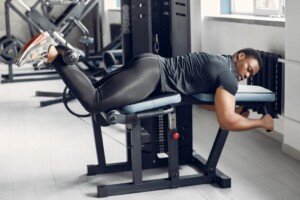
When a fitness enthusiast or athlete suffers a hamstring injury, this really blows, but if you know the causes and the solutions, this will put you way ahead of the game.
Hamstring injuries can interfere with training for fitness, sports or physique competition: a hamstring injury disrupts running, and running is a heavily favored fat-burning activity for those wanting to slash body fat. The most common cause of hamstring injuries is actually running, particularly sprinting, though overly aggressive stretching can also injure the hamstrings.
Ironically, the person with the hamstring that’s been only mildly injured by fast running may very well still be able to perform heavy hamstring curls, as well as dead-lifts, squats and leg presses.
This all assumes that the point where the hamstring changes from a muscle to tendon – the muscle-tendon junction – has not been sufficiently injured to create symptoms during weight lifting.
Otherwise, a hamstring injury will interfere with bodybuilding and strength training routines, because these exercises require the tissue to perform strong contractions.
However, weightlifting routines can be resumed during the later stages of hamstring healing, as long as these activities don’t cause pain.
A person may be ham-curling or squatting pain-free, yet still find running, or even hiking uphill, very uncomfortable.
If you’ve ever had a hamstring injury, then you know it disrupts your running program.
It may even disrupt incline walking. In addiction to knee flexion, hamstrings are responsible for hip extension, and the faster you run, the more your hip extends – and the quicker, at that.
Plus, incline walking involves hip extension as well, which is why a hamstring injury will often make its presence known when a person walks up a hill or uses an inclined treadmill.
What muscles are involved in a hamstring injury?
The hamstring group consists of three muscles, and a classic hamstring injury involves some part of this muscle group.

Freepik.com/Racool_studio
However, a strain of the neighboring adductor magnus may “feel” like a hamstring injury, and these are classified as groin strains.
Most hamstring strains involve the biceps femoris, a two-headed muscle. The muscle-tendon junction is affected over 90 percent of the time.
The chief cause of hamstring injury is coming to a walking pace or slow jogging pace abruptly off of a hard sprint.
People commonly do this on a treadmill when sprinting, often stepping off the machine directly from a 9-12 mph or faster run, then standing still to drink water or take a pulse.
Sudden deceleration also occurs outdoors during training, and also during sports participation.
Rapid deceleration causes the hamstrings to contract while in an elongated or lengthened position. This is not good for the hamstrings.
Suppose you are conducting high intensity interval training on a treadmill.
Your work intervals consist of brief sprints at, say, 12 or 14 mph. In between these speed intervals is a recovery walk or gentle jog.
However, you feel whipped as you near the end of the sprinting segment, that you either stop outright by placing your feet on either side of the whizzing tread to catch your breath, or, you slow the machine down to a casual pace that doesn’t allow your body to gradually transition out of the hard sprinting.
Either case, especially the first scenario, is rapid deceleration.
What does the injury involve?
Hamstring injuries are either first-, second- or third-degree. First-degree means microscopic tearing of muscle tissue.
Second-degree is the same except more serious, and may present with black and blue marks from local bleeding at the injury site.
A third-degree hamstring injury means a complete tear at the muscle-tendon junction or “tie-in.” This requires surgery.
Injury Prevention
“Injuries like these always occur when the amount of force that goes through the hamstring exceeds its capacity,” says Dr. Megan McLain, PT, DPT, cofounder of Intuitive Choice Physical Therapy & Wellness in Atlanta, GA.
“The problem comes in with increasing training load too quickly or trying to increase speed too quickly.
“This is especially true with interval training — so when you start running again after walking, don’t start sprinting again too quickly.
“Allow your muscles a few seconds to increase speed so that you don’t put too much strain through your hamstring tendons, which attach right under your glutes.
“Usually a quick sprint or kicking motion can put extra stress through the hamstring.
“Increase training load slowly and prioritize recovery days as well, especially if you are just starting to run or are returning after a break.”
There is no guarantee of preventing a hamstring injury, but you can maximize prevention efforts by taking a few additional measures.
Avoid rapid deceleration from a sprint, whenever possible. Obviously, during sports play, this is often not possible.
But if you’re on a treadmill or doing a training run, practice gradual transitioning out of the sprint to your slower speeds or walks.
Next, work on stretching the quadriceps muscle, since tight quads are associated with hamstring injuries.
We spend a lot of time stretching the hams, but often neglect the quadriceps.
When strength training the hamstrings, the training volume of the hamstrings should be approximately 70 percent of that of the quadriceps.

Freepik/ prostooleh
Also, the strength of your hamstrings should be at least 70 percent (relatively speaking) of the quadriceps.
For example, if you are doing leg extensions for reps at 200 pounds, but your best 8-rep max of a hamstring curl is 110 pounds, you have an imbalance of strength.
Not that you should be hamstring curling 200 pounds, but strive for at least 140 or 150 pounds for good reps.
At the first sign of a hamstring injury, cease the offending activity.
A hamstring injury can come on suddenly and acutely; but it can also develop over time, beginning in a subtle way.
 Dr. Megan McLain, PT, DPT, puts her clients first while providing one-on-one in-home care. With physical therapy and health coaching services, Dr. McLain addresses all aspects such as physical barriers, mindset, accountability and knowledge that may be impacting the client’s experience.
Dr. Megan McLain, PT, DPT, puts her clients first while providing one-on-one in-home care. With physical therapy and health coaching services, Dr. McLain addresses all aspects such as physical barriers, mindset, accountability and knowledge that may be impacting the client’s experience.
 Lorra Garrick has been covering medical, fitness and cybersecurity topics for many years, having written thousands of articles for print magazines and websites, including as a ghostwriter. She’s also a former ACE-certified personal trainer.
Lorra Garrick has been covering medical, fitness and cybersecurity topics for many years, having written thousands of articles for print magazines and websites, including as a ghostwriter. She’s also a former ACE-certified personal trainer.
.

























